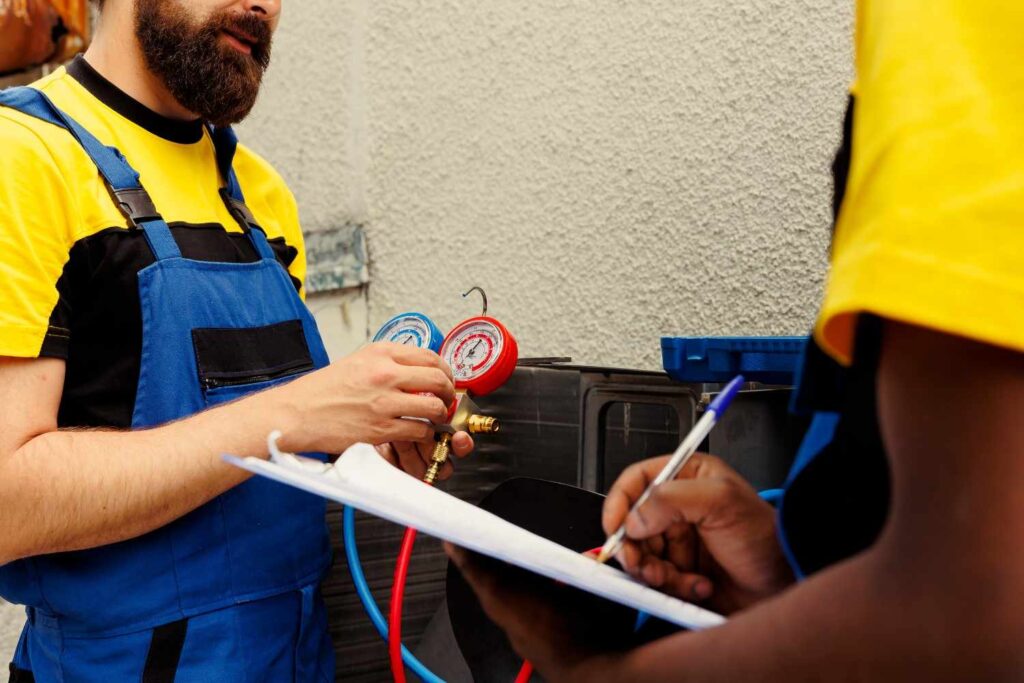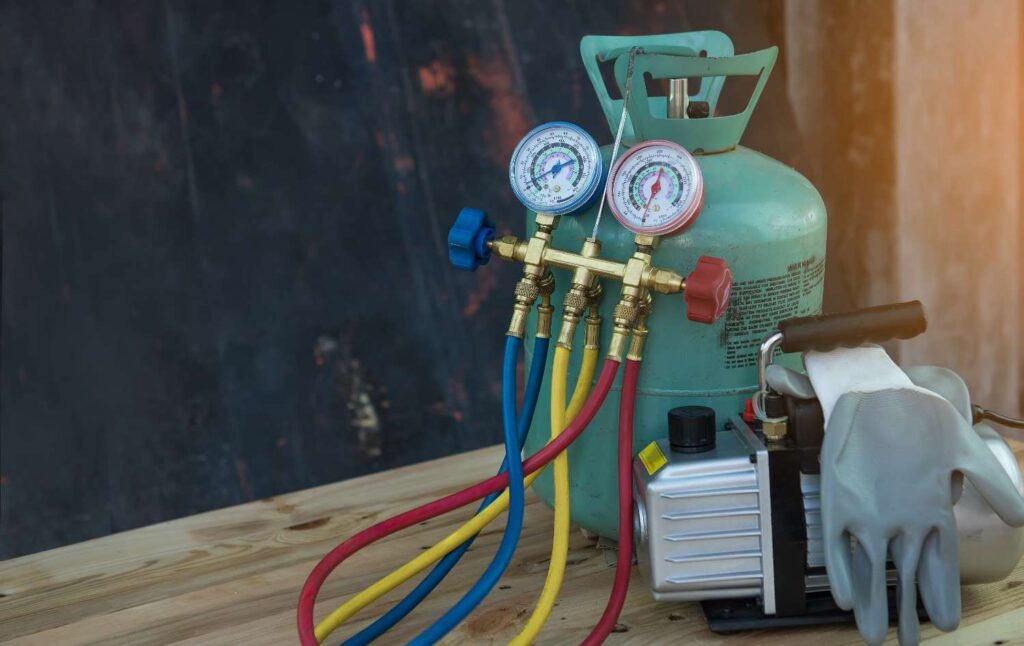When your cooling system stops delivering cold air, one of the first questions that comes to mind is: How much does it cost to refill the Freon (refrigerant) in my air conditioner?
In this expert guide, I’ll walk you through the average air conditioner Freon refill cost, what affects pricing, and when a refill might not be the best solution. We’ll also look at cost breakdowns, comparison tables, and practical FAQs so you can make informed decisions before calling a technician.
What Is an Air Conditioner Freon Refill?
“Freon” is a common term for the refrigerant used in air conditioning systems. This chemical compound absorbs and releases heat, allowing your AC to cool indoor air.
Over time, leaks or damage can cause refrigerant levels to drop. When this happens, your AC might blow warm air, freeze up, or make hissing sounds. Refilling—or recharging—the system restores the refrigerant to proper levels so the AC can function efficiently again.
However, a refill is rarely a simple “top-up.” Professionals must diagnose the system, locate leaks, and calibrate pressures to ensure your unit runs safely and efficiently.
Average Air Conditioner Freon Refill Cost in the U.S.

On average, air conditioner Freon refill costs range from $210 to $240, including refrigerant material, labor, and diagnostics.
However, prices can vary widely depending on the refrigerant type, system size, and repair needs. Here’s a typical breakdown:
| Cost Component | Estimated Price (USD) | Details |
| Diagnosis | $60 | Technician identifies leaks or issues |
| Refrigerant Material | $90–$120 per pound | Depends on refrigerant type |
| Labor | ~$120 per hour | Includes refill and calibration |
| Total (Basic Refill) | $210–$240 | Includes diagnosis and recharge |
More complex repairs—like fixing leaks or replacing coils—can raise total costs to $400–$800+, depending on system age and refrigerant type.
Factors Affecting Air Conditioner Freon Refill Cost
Several key factors determine how much you’ll pay for a Freon refill. Understanding these can help you interpret quotes and spot fair pricing.
1. Type of Refrigerant
Not all refrigerants cost the same. The most common types include:
- R-410A (Puron): Used in most modern systems. It’s more energy-efficient and widely available, making it more affordable.
- R-22 (Freon): Used in older systems. Since it’s been phased out due to environmental regulations, it’s harder to find and much more expensive.
- Newer alternatives (R-32, R-454B): These are becoming popular in newer AC units and may change price trends in the future.
2. Amount of Refrigerant Required
Your AC’s tonnage (cooling capacity) determines how much refrigerant it needs. The larger the unit, the higher the cost.
| System Size (Tons) | Typical Refrigerant Needed (lbs) | Estimated Material Cost (R-410A) |
| 1.5–2 tons | 4–8 lbs | $360–$960 |
| 3–4 tons | 6–12 lbs | $540–$1,440 |
| 5 tons | 10–20 lbs | $900–$2,400 |
Note: Material cost alone; does not include labor or diagnostic fees.

3. Leak Detection and Repair
If your system is low on Freon, it usually means there’s a leak. Detecting and repairing leaks can add $200–$600+ to your bill. Technicians may use UV dye, electronic detectors, or pressure tests to find the problem before refilling.
Skipping leak repair might save money short-term but can lead to repeated refills and long-term damage to the compressor.
4. Labor and Service Rates
Labor costs vary by location and company. In most U.S. cities, HVAC technicians charge between $100–$150 per hour. This covers system inspection, refrigerant recovery, recharging, and calibration.
In high-demand seasons—especially summer—expect rates on the higher end due to workload and urgency.
5. System Age and Efficiency
Older air conditioners are more likely to use outdated refrigerants like R-22 and have more frequent leaks or coil corrosion. That raises the cost of refills and repairs.
If your AC is over 12–15 years old, it may be worth comparing the cost of refills versus system replacement, as newer models are more energy-efficient and use eco-friendly refrigerants.
6. Regional Pricing Differences
Where you live also impacts pricing. Urban areas with high labor costs or regions with hotter climates (like Texas, Florida, or Arizona) tend to charge more for refrigerant services than cooler or rural areas.
Quick Comparison Table: What Impacts Freon Refill Pricing

| Factor | Effect on Cost | Impact Level |
| Refrigerant Type (R-410A vs R-22) | R-22 is significantly more expensive | High |
| System Size | Larger units require more refrigerant | High |
| Leak Detection or Repairs | Adds extra labor and materials | High |
| Labor/Diagnosis Fees | Varies by company and region | Medium |
| Age of System | Older systems cost more to service | Medium–High |
| Regional Variations | Hotter or urban areas charge more | Medium |
Typical Cost Scenarios
Let’s look at how these variables play out in real-world examples.
- Scenario 1: A 2-ton modern AC with R-410A and a small leak
→ Total cost: $200–$300 - Scenario 2: A 3-ton older unit using R-22 refrigerant
→ Total cost: $400–$1,000+ depending on leak size - Scenario 3: A system needing leak repair plus full recharge
→ Total cost: $700–$1,200 or higher if coils or lines are damaged
Why Refilling Isn’t Always the Right Solution
If your air conditioner needs frequent Freon top-offs, that’s a red flag. Refrigerant doesn’t get “used up” under normal operation—so losing it means there’s a leak or system fault.
Continually refilling without repairing leaks can:
- Damage your compressor over time
- Lower energy efficiency
- Increase electricity bills
- Void manufacturer warranties
In some cases, replacing an old, inefficient system can be more cost-effective in the long run than paying for repeated recharges.
How to Manage and Reduce Freon Refill Costs

Here are a few practical steps to control costs and avoid surprises:
- Schedule annual maintenance. Technicians can catch small leaks before they escalate.
- Ask for a detailed quote. Ensure it includes refrigerant type, amount, and labor.
- Compare multiple estimates. Get at least two or three quotes to benchmark pricing.
- Confirm technician certification. In the U.S., refrigerant handling requires EPA Section 608 certification.
- Consider system replacement if over 12–15 years old. New systems use efficient, eco-friendly refrigerants and may reduce energy costs by up to 30%.
Also Read: is electrical tape waterproof
Frequently Asked Questions
Q1: How often does an air conditioner need a Freon refill?
Your AC should never need regular refills. If refrigerant levels drop, it means there’s a leak. Once repaired and refilled properly, the refrigerant should last for years.
Q2: Can I refill Freon myself?
No. U.S. law prohibits unlicensed individuals from purchasing or handling most refrigerants. Handling refrigerants without certification can be dangerous and illegal.
Q3: My AC is blowing warm air—does that mean it’s low on Freon?
It could be. Low refrigerant levels can cause warm air, hissing noises, or ice buildup on the coils. However, warm air can also result from dirty filters or faulty compressors, so a technician should inspect it first.
Q4: How many pounds of Freon does my system need?
It depends on the size of your system. On average, a 3-ton AC unit uses about 6–12 pounds of refrigerant for a full charge.
Q5: What if my system uses R-22 refrigerant?
R-22 is being phased out and is no longer produced in the U.S., which makes it expensive and harder to source. If your unit still uses R-22, it might be more practical to replace it rather than pay high refill costs.
Final Thoughts on Air Conditioner Freon Refill Cost
When it comes to air conditioner Freon refill cost, expect to pay between $210 and $240 for a standard recharge, though the price can climb much higher for older systems or serious leaks.
Before authorizing a refill, make sure you understand what’s included in your quote—especially refrigerant type, labor hours, and potential repair needs.
A professional diagnosis and preventive maintenance go a long way in avoiding unnecessary expenses and keeping your cooling system efficient for years to come.










